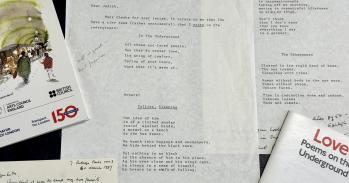
The writer Nan Shepherd (1893-1981), who was quietly acclaimed in her lifetime, is the face of a new Royal Bank of Scotland bank note. One of Shepherd’s staunchest supporters is Robert Macfarlane (Faculty of English), who wrote the introduction to her book about the Cairngorms.
The writer Nan Shepherd (1893-1981), who was quietly acclaimed in her lifetime, is the face of a new Royal Bank of Scotland bank note. One of Shepherd’s staunchest supporters is Robert Macfarlane (Faculty of English), who wrote the introduction to her book about the Cairngorms.
She found her own path in life and in literature, and it feels like she’s so far ahead of us – we’re always only starting to catch Nan up. Philosophically and stylistically, she was extraordinary.
Robert Macfarlane
The term ‘nature writing’ didn’t exist in the 1940s when Nan Shepherd wrote The Living Mountain, a book in which she describes exploring the Cairngorm Mountains in north-east Scotland as a walker and writer. Shepherd sent her manuscript to a novelist friend called Neil Gunn. He responded with praise (“This is beautifully done,” he wrote) but suggested that Shepherd might find it hard to get her work published unless she added photographs and a map.
The Living Mountain defies categorisation. It was turned down by the one publisher to whom Shepherd sent it. Gunn remained the book’s sole reader right up until 1977, when the book was finally published by Aberdeen University Press (with a map but no photographs). In a preface, Shepherd notes that 30 years in the life of a mountain is nothing (“the flicker of an eyelid”), but that many things had happened in the Cairngorms between her writing of the book and its publication.
She lists the ‘eruption’ of the resort of Aviemore, the growing impact of tourism and terrible tragedies of lives lost in accidents. She follows her list with a message that speaks of her intense relationship with landscape in all its moods: “All these are matters that involve man. But behind them is the mountain itself, its substance, its strength, its weathers. It is fundamental to all that man does to it or on it.”
Last month the Royal Bank of Scotland (RBS) announced the designs of two polymer banknotes to be issued later this year. Both feature portraits of women. The new £10 note will bear the face of the scientist Mary Somerville and the £5 note the face of Nan Shepherd.
The portrait on the new £5 note is based on a photograph taken of Shepherd as student at Aberdeen. Her calm face is framed by long hair parted in the middle and held by a headband. Shepherd was famously averse to notions of glamour (though she always walked in skirts, never trousers) and with her bold eyes, and steadfast gaze, she makes an understated heroine.
Shepherd’s appearance in the public sphere will raise the profile of an author whose work has at times risked falling from view, and whose writing helped to lay the foundations for the current flowering of writing about place, people and nature. The accolade accorded her by RBS has been welcomed by the growing number of readers who enjoy Shepherd’s prose and poetry – all of which is centred on her deep appreciation of the Scottish landscape.
Robert Macfarlane (Faculty of English) has written extensively on Shepherd, seen her poetry back into print after 80 years, and presented both television and radio programmes about her for the BBC. In an interview with the Guardian, Macfarlane called Shepherd a “brilliant, progressive choice” for the £5 note.
“She’s an incredibly inspiring figure, and an unusual one, in the sense of being a woman writing about mountains and the wilderness and nature,” he said. “She found her own path in life and in literature, and it feels like she’s so far ahead of us – we’re always only starting to catch Nan up. Philosophically and stylistically, she was extraordinary.”
Macfarlane spent many of his childhood holidays in the Cairngorms, where he developed a love for the Scottish Highlands. But he came across Shepherd’s writing only just over a decade ago. He has since read and reread her books and poetry, as well as teaching regularly on Shepherd and her work to both undergraduates and graduates.
In his latest book, Landmarks (2015), Macfarlane writes that reading The Living Mountain changed him: “I had thought that I knew the Cairngorms well, but Shepherd showed me my complacency. Her writing taught me how to see these familiar hills rather than just to look at them.” He was influenced by Shepherd’s emphasis on mountain-going as a pilgrimage rather than a conquest, and by her readiness to peer into what she calls ‘nooks and crannies’, in order to know better ‘the total mountain’.
In The Living Mountain, Shepherd describes making a similar discovery when she began walking in Scotland. She writes: “At first, mad to recover the tang of height, I made always for the summits and would not take time to explore the recesses.” A turning point came when a friend took Shepherd to Loch Coire an Lochain, a stretch of water that lies hidden in the hills. It was a September day, following a storm, and “the air was keen and buoyant, with a brilliancy as of ice”.
Dipping her fingers into the frost-cold waters, Shepherd listens to the sound of the waterfall until she no longer hears it. She lets her eyes travel over the surface of the water from shore to shore – not once but twice. “There is no way like that for savouring the extent of a water surface,” she writes. “This changing of focus in the eye, moving the eye itself when looking at things that do not move, deepens one’s sense of outer reality.”
Shepherd did not talk about walking up mountains but walking into them. Her writing is sometimes mystical but never gushingly romantic – water is “appalling” in its strength, birches are most beautiful when “naked”. She was a keenly acute observer, each of her words chosen with such razor-sharp precision that she feared that her writing would be considered cold and inhuman.
Sensual is one of the words Macfarlane uses to describe Shepherd’s work. She herself wrote that she found “a joyous release” in walking and climbing, often toiling through foul weather. The Living Mountain begins with the observation: “Summer on the high plateau can be as sweet as honey; it can also be a roaring scourge. To those who love the place, both are good, since both are part of its essential nature.”
It was through a process of immersion – sleeping outdoors, wading through streams, and sometimes swimming in the burns, watching and observing – that Shepherd got to know the colours and textures of the Cairngorms. Long before ecology became fashionable, she spoke about the interconnectedness of nature in a way that sprung from feeling rather than learning.
In an essay written to preface the 2011 edition of The Living Mountain, Macfarlane draws attention to a passage in which Shepherd experiences the vastness of life. “So there I lie on the plateau, under me the central core of fire from which was thrust this grumbling grinding mass of plutonic rock, above me blue air, and between the fire of the rock and the fire of the sun, scree, soil and water, moss, grass, flower and tree, insect, bird and beast, wind, rain and snow – the total mountain.”
For Shepherd there was a kind of magic in the act of walking itself and the way in which the human body adapts to the earth’s surface. "Eye and foot acquire in rough walking a coordination that makes one distinctly aware of where the next step will fall, even when watching land and sky." Countless walkers will have felt the same thing - but few will have put it into words so neatly.
For almost all her life, Shepherd lived in the house where she had been born. She travelled widely but always returned to the hills she loved. Macfarlane suggests that Shepherd’s focus on a particular place, one not far from her doorstep, led to a deepening rather than a restriction of knowledge. “The Living Mountain needs to be understood as parochial in the best sense,” he has written.
“Because it’s there” was the climber George Mallory’s famous retort to the question of why he climbed Everest. Shepherd’s reasons for walking the Cairngorms are imbued with the same intense ‘thereness’ but none of the high drama of conquest. She sought to know these rugged hills in a sense both quiet and fierce. “Knowing another is endless,” she wrote, “The thing to be known grows with the knowing.”

The text in this work is licensed under a Creative Commons Attribution 4.0 International License. For image use please see separate credits above.




